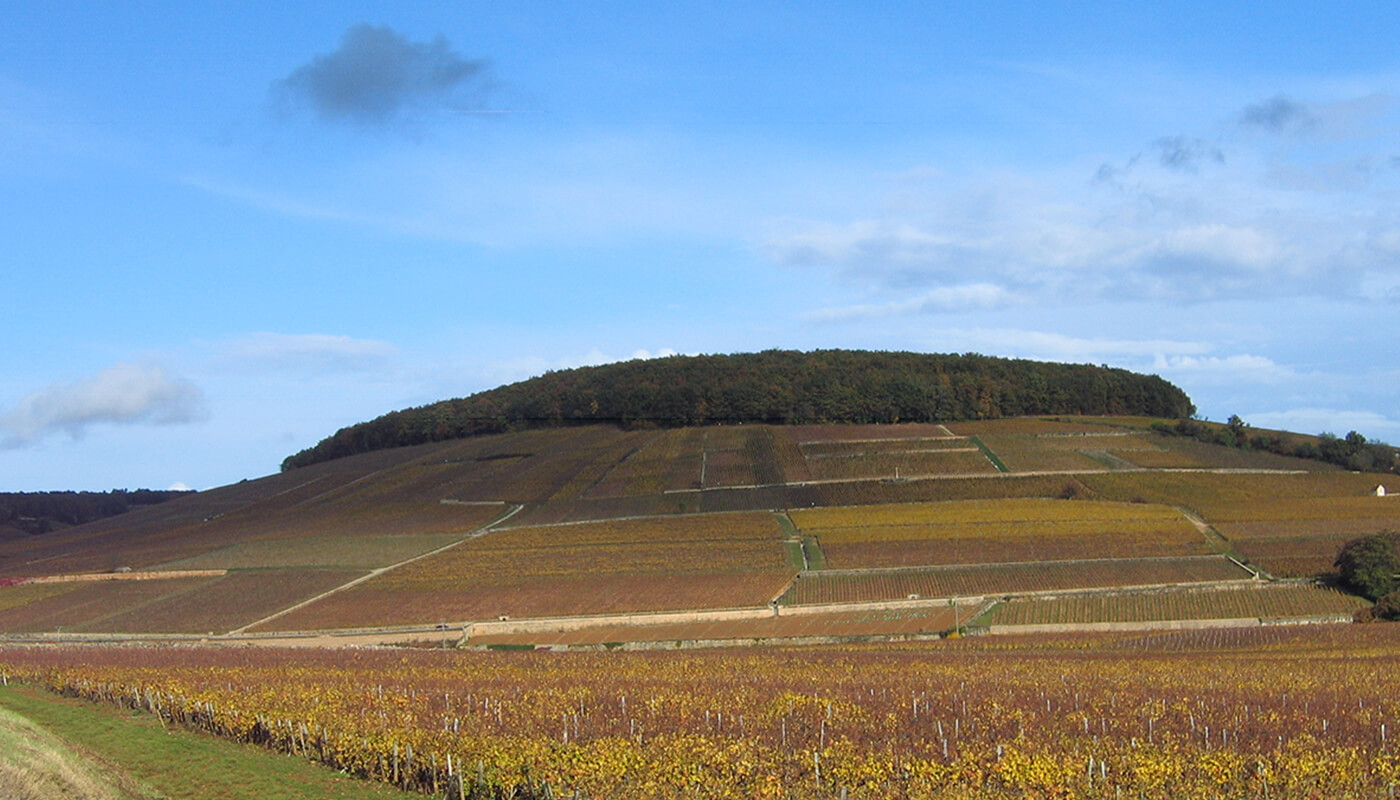Since the 2009 vintage, Domaine de la Romanée-Conti has leased part of the mid-slope plot at Domaine Prance Florent de Melode to produce its Corton red wine. In addition to this, from 2019 we have leased the best parcel of land at Domaine Bonneau du Martoray to produce a white wine, Corton Charlemagne. The first vintage, the 2019, will be released in the spring of 2022.
Difficult labelling
The Côte d'Or (Golden Hills), home to some of Burgundy's greatest vineyards, is divided into two regions: the Côte de Nuits in the north and the Côte de Beaune south of the Corton hill. While Burgundy's most famous red wines, such as Romanée-Conti and Musigny, are produced in the Côte de Nuits, its most famous white wines, such as Montrachet and Corton-Charlemagne, come from the Côte de Beaune.
The first thing you see as you drive north from the walled city of Beaune on Route 74 is the Colton hill, shaped like the Tokyo Dome. At 388 metres high, with forest around its summit and vineyards on the surrounding slopes, from a distance the Colton hill looks like a two-blocked head of hair, with the top of the head long and the sides cropped. Much of the slopes of the Corton hill are classified as Grand Cru, and the Corton (red), the only Grand Cru red wine from the Côte de Beaune, is a large Burgundy vineyard covering 160 hectares.
In Burgundy, where appellations of origin and wine names are complex and confusing, the labelling of the wines of Corton Hill is a source of confusion for consumers and distributors alike. To put it in the simplest possible terms, the Corton hill vineyards are divided into a number of different parcels, some of which can bear the name "Corton" under the Appellation d'Origine Contrôlée, and others which bear the name "Corton Charlemagne". "Corton Charlemagne is located at the top of the slopes, while Corton is located at the bottom. When it comes to naming the wines on the label, white wines from the "Corton Charlemagne" plots are sold under the name "Corton Charlemagne", while red wines are sold under the name "Corton". Red wines from the "Corton" plots are sold under the name "Corton", while white wines are labelled as "Corton Blanc". The reason why the French Appellation d'Origine Contrôlée does not allow white wines from the Corton parcel to bear the more famous name of Corton-Charlemagne is that it does not want white wines to be made from the red-soil Corton parcel, which is considered more suitable for red wine production. In fact, the Grand Cru 'Corton Blanc' is rarely seen on the market anymore.
What makes the wines of the Corton hills hopelessly esoteric for the consumer is the widespread use of the above-mentioned Grand Cru names of "Corton Charlemagne" (white) and "Corton" (red) and "Corton Blanc" (white) followed by the name of the parcel. For example, a red wine from the "Clos du Roi" parcel is usually sold under the name "Corton Clos du Roi", while "Corton Bressand", "Corton Renaldo", "Corton Ronier" and so on, just to name a few of the more widely available names. The list is endless.
On the other hand, within the group of parcels that call themselves "Corton-Charlemagne", there is a parcel called "en Charlemagne 1)" which, if white wine is made from it, is automatically labelled "Corton-Charlemagne", whereas if red wine is made from it, it can be labelled "Corton-en-Charlemagne 2)". If a white wine is made here, it is automatically labelled "Corton-Charlemagne", while a red wine can be labelled "Corton-en-Charlemagne 2)". However, how many people, when told that a wine is "Corton-en-Charlemagne", will understand that it is a red wine and not a white wine?
Red wine slumps
Corton is the only red wine from the Côte de Beaune region to be classified as a Grand Cru, but it has been lacking in top producers such as Domaine de la Romanée-Conti and Henri Jayet in Vosne-Romanée and Domaine Comte Georges de Vogüé in Chambolle-Musigny. As a result of the lack of top quality producers, its red wines have long had a mediocre image. For example, in his 1990 book Burgundy, the wine critic Robert Parker described the village of Arlaus-Corton, where the Corton vineyard is located, as "a region of great white and overrated red wines". Indeed, the Chardonnay for white wines is planted in well-drained plots on the upper slopes of the Corton hill, whereas the Pinot Noir for red wines is spread out on the lower slopes, where the topsoil is deeper and less well-drained. Colton, a speciality vineyard, also extends into the neighbouring village of Ladois-Serigny, but in the neighbouring village of Nuits-Saint-Georges, the lower slopes of the vineyard are not Grand Cru. For Corton reds to be considered among Burgundy's leading red wines, it is considered necessary to downgrade the lower slope vineyards, which tend to produce wines of inferior quality.
AS MENTIONED AT THE BEGINNING, DRC HAS BEEN PRODUCING CORTON REDS FROM ITS MID-SLOPE PLOTS SINCE THE 2009 VINTAGE AND DOMAINE COCHE DURY, ONE OF THE PRODUCERS OF THE BEST CORTON CHARLEMAGNE, HAS BEEN BOTTLING CORTON REDS SINCE THE SAME PERIOD. THE CORTON RENAULTS VINIFIED BY DOMAINE LEROY HAVE ALWAYS BEEN REGARDED AS THE BEST CORTON REDS AND SELL FOR MORE THAN THE CORTON CHARLEMAGNE OF COCHE DURY. INSPIRED BY THESE HIGH PRICED BOTTLES, THE QUALITY OF CORTON'S RED WINES IS ABOUT TO CHANGE DRAMATICALLY.
THIS AUCTION INCLUDES NOT ONLY THE HARD-TO-FIND CORTON CHARLEMAGNE FROM COCHE DURY, BUT ALSO THE VERY RARE CORTON RED FROM THE SAME ESTATE, CORTON CHARLEMAGNE FROM DOMAINE LEROY, CORTON FROM THE DRC, AND A LARGE QUANTITY OF CORTON CHARLEMAGNE AND CORTON RED FROM DOMAINE BONNEAU DU MARTORAY. CORTON CHARLEMAGNE AND CORTON RED FROM DOMAINE BONNEAU DU MARTORAY.


